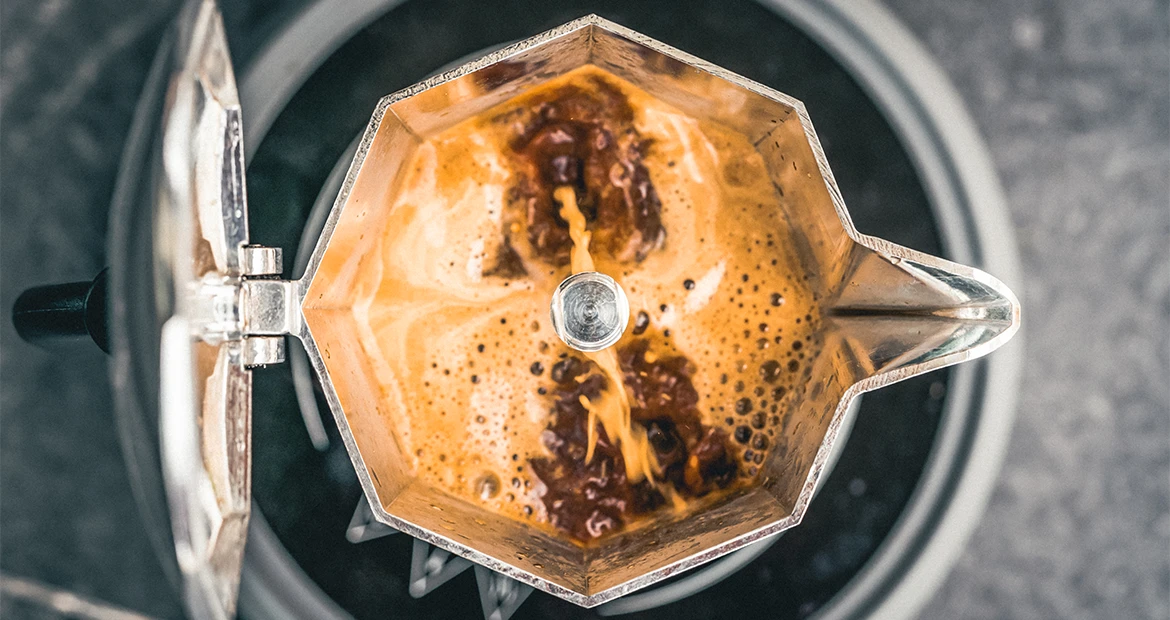Master the Art of Brewing Moka Pot: A Step-by-Step Guide
20 Feb 2023 2023-09-12 9:17
Master the Art of Brewing Moka Pot: A Step-by-Step Guide
Brewing rich, full-bodied coffee with a Moka Pot.
What you'll need
Table of Contents
Coffee Dose
Grind Size
Water + Temp
Brew time
The Best Moka Pot Recipe
Step 1
Fill the bottom chamber of your Moka Pot with warm water.
Step 2
Add your coffee grounds to the filter basket.
Step 3
Place the filter basket into the bottom chamber, making sure it's securely in place.
Step 4
Put the top chamber in place and screw on the lid, making sure it's tightened securely.
Step 5
Place the Moka Pot on the stove and turn the heat to medium-high.
Turning the heat to medium-high allows the water to boil and build pressure, which is necessary for the brewing process.
Once the water starts to boil and pressure builds, you’ll hear a gurgling sound. This gurgling sound means that the coffee is being forced up into the top chamber. Keep an ear out for this sound and turn off the heat once all the coffee has been pushed into the top chamber.
Step 6
Once all the coffee has been pushed into the top chamber, turn off the heat and remove the Moka Pot from the stove.
Step 7
Enjoy
Introduction
Brief Overview of Moka Pot
Moka Pot, a coffee maker that has been in use since 1933, is also known as stovetop coffee due to its mode of operation – brewing coffee on a stove or hotplate. It comprises a base, filter basket, coffee chamber, and lid, which work together to produce a unique and rich flavour profile that has made it a favourite among coffee enthusiasts.
Importance of Moka Pot in Coffee Culture
Moka Pot has become a popular coffee brewing method among coffee enthusiasts due to its simplicity, versatility, and the ability to produce rich and flavorful coffee. Unlike expensive espresso machines, Moka Pot is an affordable and accessible alternative for home coffee brewing, which adds to its appeal.
Brief History of Moka Pot and Its Popularity
Moka Pot vs Espresso
Strength Comparison
Caffeine Content
Differences in Flavor
Are Moka Pots Worth It?
Pros and Cons of Using Moka Pots
Pros
Affordability: Moka Pots are often less expensive compared to espresso machines and other coffee brewing gear.
Convenience: Moka Pots are easy to use and clean, making it a great option for home coffee brewing.
Flavour: Moka Pot coffee is known for its rich and full-bodied flavour.
Versatility: Moka Pots can be used with a variety of specialty coffees, from coffee blends to single origin.
Cons
Brew Time: Moka Pot coffee can take longer to brew compared to other methods such as espresso or French Press.
Limited Capacity: Moka Pots are usually limited to making small amounts of coffee at a time.
Limited Control: The brewing process of Moka Pot coffee is more limited compared to other methods, giving the user less control over the final product.
Factors to Consider When Choosing Moka Pots
Size: Choose a Moka Pot that is the right size for your needs.
Material: Moka Pots are available in various materials such as aluminium, stainless steel, and copper. Choose the material that best suits your needs and preferences.
Ease of Use: Consider the ease of use when choosing a Moka Pot. Look for models that are easy to fill, pour, and clean.
Price: Consider your budget when choosing a Moka Pot. Prices can vary widely depending on the size, material, and brand.
Comparison with Other Coffee Brewing Gear
Aeropress
French Press
Italian Culture and Moka Pots
Moka Pots in Italian Homes and Coffee Shops
Popularity of Moka Pots Among Italians
Italian Coffee Culture and Its Impact on Moka Pots
Caring for Your Moka Pot
Cleaning and Maintenance
Caring for your Moka pot is important to ensure that it lasts for a long time and performs at its best. Here are some tips for cleaning and maintaining your Moka pot:
- After each use, disassemble your Moka pot and wash the parts in warm soapy water.
- Make sure to dry them thoroughly before reassembling.
- Avoid using abrasive cleaning materials, such as steel wool or scouring pads, as they can scratch the surface and compromise the pot’s performance.
- Store your Moka pot in a dry place to prevent rusting.
Avoiding Mould Growth in Moka Pots
Mould can grow in your Moka pot if it is not cleaned regularly or if it is not dried properly after each use. To prevent mould growth:
- Clean your Moka pot after each use.
- Make sure to dry the parts thoroughly before reassembling.
- Store your Moka pot in a dry place.
How to Properly Clean Moka Pots
To properly clean your Moka pot, follow these steps:
- Disassemble the pot.
- Rinse the parts in warm water.
- Wash the parts in warm soapy water.
- Rinse the parts again in warm water.
- Dry the parts thoroughly.
- Reassemble the pot.